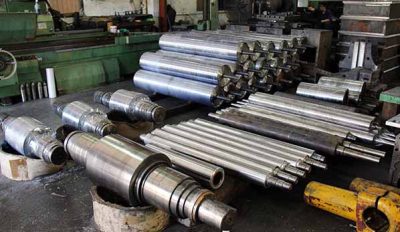In the processing of large horizontal lathes, the constant-distance ripples and chaotic ripples often occur repeatedly. How to solve this annoying problem? Please listen to the KANGDING technicians to help you.
ತಿರುಗುವ ಸಮಯದಲ್ಲಿ ದೊಡ್ಡ ಸಮತಲವಾದ ಲ್ಯಾಥ್ಗಳಲ್ಲಿ ಪಿಚ್ ತರಂಗಗಳ ಪುನರಾವರ್ತಿತ ಸಂಭವಿಸುವಿಕೆಯ ದೃಷ್ಟಿಯಿಂದ. ಸಂಭವನೀಯ ಕಾರಣವೆಂದರೆ ಫೀಡ್ ಸಿಸ್ಟಮ್ನ ಟ್ರಾನ್ಸ್ಮಿಷನ್ ಗೇರ್ನ ಮೆಶಿಂಗ್ ಅಂತರವು ಅಸಹಜ ಅಥವಾ ಹಾನಿಯಾಗಿದೆ. ಪರಿಹಾರವು ತುಂಬಾ ಸರಳವಾಗಿದೆ, ಅಂತರವನ್ನು ಸರಿಪಡಿಸಿ. ಕೆಲವೊಮ್ಮೆ, ದೊಡ್ಡ ಸ್ಲೈಡ್ ಪ್ಲೇಟ್ ಮತ್ತು ಬೆಡ್ ಗೈಡ್ ರೈಲಿನ ರೇಖಾಂಶದ ಬದಿಗಳಲ್ಲಿನ ಒತ್ತಡದ ಪ್ಲೇಟ್ ನಡುವಿನ ಅಂತರವು ತುಂಬಾ ದೊಡ್ಡದಾಗಿದೆ, ಮತ್ತು ಸ್ಥಿರ ದೂರದ ಏರಿಳಿತವು ಪದೇ ಪದೇ ಕಾಣಿಸಿಕೊಳ್ಳುತ್ತದೆ, ಮತ್ತು ಅಂತರವನ್ನು ಸೂಕ್ತವಾಗಿ ಸರಿಹೊಂದಿಸಲು ಸಾಕು. If the polished rod is bent, the coaxiality between the hole supporting the polished rod and the polished rod is too poor, or the rod is not parallel to the bed rail, it will cause the fixed distance wave to appear. ಈ ಸಮಯದಲ್ಲಿ, straighten up and adjust the parallelism.
Large-scale horizontal lathes often have various problems in turning processing: ಉದಾಹರಣೆಗೆ, the roundness is out of tolerance, the end face perpendicularity and the flatness are out of tolerance, ಇತ್ಯಾದಿ. Here is how to solve such problems.
The out-of-roundness situation in the machining of the horizontal large lathe may be related to the following three situations: One is that the matching screws of the chuck flange and the spindle are loose, or the chuck positioning surface is loose. The solution is to re-tighten. The second is that the bearing clearance of the main shaft is large, the matching clearance between the outer diameter of the main shaft sleeve and the box body is large, or the roundness of the main shaft journal is out of tolerance. ಈ ವಿಷಯದಲ್ಲಿ, the clearance should be readjusted or the main journal should be ground. The third is that the wall of the workpiece hole is thin and the clamping is deformed. Workers can use plastic clamps or reserve process heads for easy clamping.

ದೊಡ್ಡ ತಿರುವು ಭಾಗಗಳು
The cylindricity is poor, and there are many reasons for this.
1. The blank is bent. ಈ ವಿಷಯದಲ್ಲಿ, only need to be straightened.
2. There is a problem that the axis of the lathe spindle and the guide surface of the bed are not parallel in the horizontal plane;
3. The front and back tops are not equal in height or the center is shifted;
If the top tightening force is improper, the problem of poor cylindricity will also occur. Workers should adjust the clamping force or switch to elastic top clamps.
In addition to the four reasons listed above, there are many reasons that can cause poor cylindricity in horizontal large lathe machining. Insufficient clamping rigidity of the workpiece can also cause this problem. Workers need to change the front and rear top clamping to chuck, top clamping, or use tool holders, ಆವರಣಗಳು, ಇತ್ಯಾದಿ. to increase the machining rigidity of the workpiece. The tool is worn out in one feed or the tool shaft is too thin, causing the tool to give way. Workers should reduce the turning speed, improve the wear resistance of the tool and increase the rigidity of the tool holder; When turning stress and turning heat produce deformation, the stress should be eliminated, the turning speed and feed rate should be increased as much as possible, the cutting thickness should be reduced, the turning process should be performed multiple times, and the cooling and lubrication should be strengthened; Too much distance between the tip of the tool and the support of the tool post can also cause this problem. Just reduce the distance appropriately.
 English
English العربية
العربية 中文(漢字)
中文(漢字) Čeština
Čeština Dansk
Dansk Nederlands
Nederlands Suomi
Suomi Français
Français Deutsch
Deutsch Italiano
Italiano 日本語
日本語 ಕನ್ನಡ
ಕನ್ನಡ 한국어
한국어 Português
Português Русский
Русский Slovenčina
Slovenčina Español
Español Svenska
Svenska Türkçe
Türkçe

